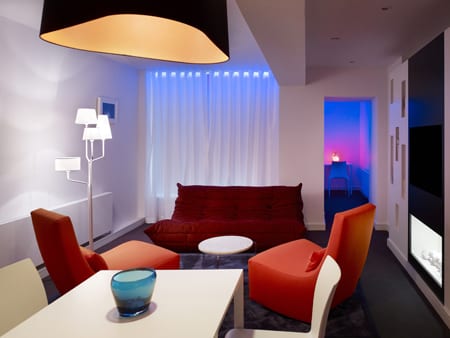Hospitality Design (HD) magazine and Culintro, a culinary trade organization in New York City that brings together restaurant professionals, have teamed up to bring a monthly online Q&A with some of the nation’s top restaurant designers. Each month, we will feature a Q&A with an industry leader, talking about his/her newest project, the industry, what works, and what’s next.
 Lionel Ohayon
Lionel Ohayon
President and Founder
ICRAVE
New York City
www.icravedesign.com
If you like going out in New York or Los Angeles, there’s a good chance you have eaten or drank at an ICRAVE-designed space. Cool is the firm’s specialty and clients keep coming back for more. Founded in January of 2002 by Lionel Ohayon, the now 30-person firm has designed a slew of successful restaurants, lounges, and nightclubs such as STK, Sushi Samba, Koi, Crobar, and Hyde Lounge. And Ohayon is just getting started—he has his first hotel under his belt and he made headlines with his airport dining designs. In between trips, we caught up with the jetsetter to discuss his secret to keeping clients, lessons learned, and his favorite memory with U2.
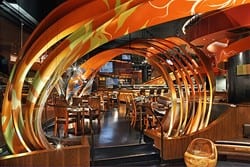 HD: Why did you want to start your own firm?
HD: Why did you want to start your own firm?
LO: I always imagined having my own firm. I named it ICRAVE because I loved the concept of desire which plays a pivotal role in my work. Adapting the copyright symbol in the logo spoke to the notion that we are creating objects of value and ideas and that they are precious and worth protecting
HD: How would you describe your office’s culture?
LO: The studio culture is relaxed, inspired, and vital. There is a tremendous amount of talent and passion in the studio. We try our best to keep the environment relaxed and positive and continue to push the creativity by challenging everyone to show up with ideas and not to be afraid of failure.
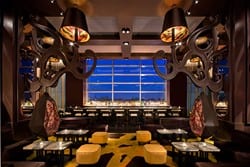 HD: What do you think was your first big break in the design world? In the restaurant world?
HD: What do you think was your first big break in the design world? In the restaurant world?
LO: I think the best break for me was University of Waterloo School of Architecture, and I owe a lot to the education I received there and developed an attitude about what design can be—UofW taught us rigor and fearlessness. In the business sector, the best break was probably beginning with a lounge called Pangaea, which then spawned a long stretch of lounges in Manhattan for ICRAVE. Getting our first hotel, W Atlanta, was very satisfying and the project put us on a different level in terms of what clients believed we were able to realize.
HD: One client you have done a ton of work for is the One Group, from One Little West 12th to STK and One and STK outposts in LA. Can you talk to me about that partnership? Why does it work so well?
LO: Mutual respect—we have learned a lot from each other.
HD: Speaking of another repeat client, you just designed Abe and Arthur’s and Simyone Lounge for the EMM Group, which you also designed TenJune and the Chandelier Room for. What was the concept here?
LO: Abe & Arthur’s is in the Meatpacking District. This restaurant cues itself off of the regenerative life cycles of the district’s past lives as a manufacturing sector/meat market/its blight, Subversive life into the limelight as an entertainment and fashion mecca. We were keen on playing up the notion of going out, what we called ‘The Big Night’ while allowing it to have another personality as a neighborhood hangout that feels very comfortable. In the same way, it does what the district does…it allows its personalities as diverse as they may be to show themselves and create a texture that is both new and contextual. This layering is what makes the area so rich. We spent the better part of a year designing the main dining room art piece feature, which is a layered collage that speaks directly to these different life cycles of the area while placing the dimmers into the mural through the use of two-way glass—I think it works quite well.
 HD: One project that is getting rave reviews is the handful of restaurants you designed at the new JetBlue Terminal 5 in New York. What was it like to help re-define airport dining?
HD: One project that is getting rave reviews is the handful of restaurants you designed at the new JetBlue Terminal 5 in New York. What was it like to help re-define airport dining?
LO: Jet Blue was a very exciting project for us. We had three focal points that were all very important to us. No. 1, no one had addressed the modern traveler’s basic needs; people are always scrambling in an airport to find a convenient outlet to recharge a cell phone or work on a laptop. That seemed like a basic requirement No. 2, the experience in the terminal should be commensurate to the experience of the city—a sidewalk seemed imperative to great design, and social gathering also paramount as well as the patchwork and varied spaces that make up any New York streetscape. No. 3, relieving traveler anxiety. It seems so simple now but we realized that if you could alleviate traveler anxiety, people will spend more time at the airport and actually enjoy the experience. With the design of the re:vive tables at the gate hold areas, we addressed the fact that many travelers go immediately to their gate when they get to an airport terminal. We also understood the impact that white tablecloths have on the psyche in terms of how much of a time commitment they symbolize…between those two ends of the spectrum travelers have many options at T5.
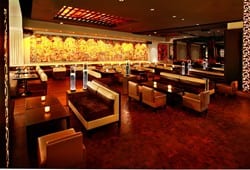 HD: Blurring the line between restaurants and nightlife is something that you strive at. Can you talk a bit about this and how you can create such a great space that can evolve from dining to hip nightspot?
HD: Blurring the line between restaurants and nightlife is something that you strive at. Can you talk a bit about this and how you can create such a great space that can evolve from dining to hip nightspot?
LO: I think restaurants are definitely trending away from designed environments and more towards a sense of authenticity. The irony is that this requires a lot more design time, but I think this move towards the open kitchen and the relaxed but natural/organic food allows simple design to make sense both in regards to where we are economically, and where we are in the end of a design cycle which I think was an important development for architects and designers. This last design cycle had design at the forefront of the real estate boom. It became essential and therefore good business to hire architects and designers to make a project successful. I’m certain I’ve never seen that before in my university or professional life, and I am afraid we may not see that direct of a link for quite some time.
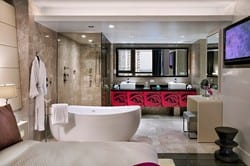 HD: Last year you designed your first hotel—the W Hotel Midtown Atlanta. Talk to us about the project. How was it to design your first hotel?
HD: Last year you designed your first hotel—the W Hotel Midtown Atlanta. Talk to us about the project. How was it to design your first hotel?
LO: I learned this designing the W: every person in the world is an expert on the design of the ‘standard room’…I really think client input is essential and I demand it from my clients, but in the ‘standard room’ when every person involved has a view of what things should/could be, you find yourself in a design-by-committee forum. To me that never works. We had a blast designing the W…I don’t think I’ll ever forget finding out that we were awarded the commission. It was an affirmation that we were moving forward and achieving our business goals. I was on a plane back from the presentation in Atlanta when I found out, and I ordered a double whiskey on the rocks and listened to U2 ‘Running to Stand Still’ the whole way home.
 HD: Any other great projects you are working on?
HD: Any other great projects you are working on?
LO: Provocateur [the new nightclub at the Gansevoort hotel in New York City] has been a very interesting project. The client has really had an enormous amount of challenges to get the project off the ground. Very few people realize the number of obstacles a project in New York goes through before it is realized. When we look at a finished product we always remember the layers of scrutiny. Local laws, building department codes, labor laws, designer tantrum, owner tantrum, construction budget, landlords, schedules, value engineering, community boards, etc. If a project still looks good after its been through this phalanx of traps then you really need to be proud of it. I look at buildings all the time and just shake my head and say, ‘how did they pull that off!?’ That’s inspiring. This client here pushed through and Provocateur should be a very sexy little spot. It has a nice balance between fantasy and folly and has a very unique garden venue which we hope will be a great feature for the neighborhood.
HD: With all of these projects, you seem to be busy. How are you faring in this economy?
LO: We are busy. We are now examining what busy means for us and how to properly manage our work load. We have been lucky and fared well though this year. I think it helped us grow and be mindful of the projects we want to do and why.
HD: Besides the economy right now, what’s the hardest part about the industry?
LO: Seeing a good idea get sidelined because the client didn’t see the vision…then try to figure out No. 1: how I missed the opportunity; No. 2: how to get my team excited about doing a watered down version…or a completely new one.
HD: Best part?
LO: The arc from idea to reality.
HD: What is it about hospitality do you love?
LO: What’s not to love?
HD: You have worked in a lot of cities. What area/city do you still want to work in?
LO: Israel, Brazil, Europe.
HD: Is there one city you are watching in terms of development?
LO: London
HD: Since you have designed so many restaurants in New York, do you go there or like eating at restaurants not designed by you and your firm?
LO: I love being in restaurants I didn’t design. I think it’s because I’m not looking at all the mistakes

